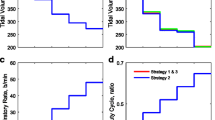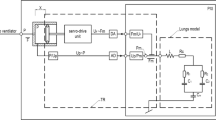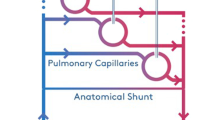Abstract
Mechanical ventilation is a life-saving intervention, which, despite being routinely used in ICUs, poses the risk of causing further damage to the lung tissue if the ventilator is set inappropriately. Medical decision support systems may help in optimizing ventilator settings according to therapy goals given by the clinician. Before using the decision support algorithms in commercially available systems, extensive tests are necessary to ensure patient safety and correct decision making. Model-based patient simulators can assist in evaluating such decision support systems by creating different clinical scenarios. We propose a new Java based patient simulator that implements various models of respiratory mechanics, gas exchange and cardiovascular dynamics to form a complex patient model. The implemented models interact with one another to allow simulation of the ventilators influence on various physiological processes. Model simulations are running in real-time and simulation results can be extracted via multiple interfaces. Each of the implemented models has been validated to exhibit physiologically correct behavior. Results of the combined model system also showed to be physiologically plausible.
The original version of this chapter was inadvertently published with an incorrect chapter pagination 697–702 and DOI 10.1007/978-3-319-32703-7_134. The page range and the DOI has been re-assigned. The correct page range is 703–708 and the DOI is 10.1007/978-3-319-32703-7_135. The erratum to this chapter is available at DOI: 10.1007/978-3-319-32703-7_260
An erratum to this chapter can be found at http://dx.doi.org/10.1007/978-3-319-32703-7_260
Access this chapter
Tax calculation will be finalised at checkout
Purchases are for personal use only
Preview
Unable to display preview. Download preview PDF.
Similar content being viewed by others
References
D. Dreyfuss and G. Saumon (1998) From ventilator-induced lung injury to multiple organ dysfunction. Intensive Care Med 24:102-4
A. S. Slutsky and L. Tremblay (1998) Multiple System Organ Failure – is mechanical ventilation a contributing factor. Am J Respir Crit Care Med 157:1721-5
G. Nash, J. B. Blennerhassett, and H. Pontoppidan (1967) Pulmonary lesions associated with oxygen therapy and artificial ventilation. N Engl J Med 276:368-74
R. S. Campbell, R. D. Branson, and J. A. Johannigman (2001) Adaptive support ventilation. Respir Care Clin N Am 7:425-40, ix
S. Lozano, K. Möller, A. Brendle et al. (2008) AUTOPILOT-BT: a system for knowledge and model based mechanical ventilation. Technol Health Care 16:1-11
S. E. Rees, C. Allerød, D. Murley et al. (2006) Using physiological models and decision theory for selecting appropriate ventilator settings. J Clin Monit Comput 20:421-9
G. W. Rutledge, G. E. Thomsen, B. R. Farr et al. (1993) The design and implementation of a ventilator-management advisor. Artif Intell Med 5:67-82
F. T. Tehrani and S. Abbasi (2012) A model-based decision support system for critiquing mechanical ventilation treatments. J Clin Monit Comput 26:207-15
F. T. Tehrani and J. H. Roum (2008) Flex: a new computerized system for mechanical ventilation. J Clin Monit Comput 22:121-30
C. Schranz, T. Becher, D. Schadler et al. (2014) Model-based setting of inspiratory pressure and respiratory rate in pressure-controlled ventilation. Physiol Meas 35:383-97
F. Galia (2010) Supervision automatique de la ventilation artificielle en soins intensifs: investigation d’un système existant et propositions d’extensions., PhD Thesis, Engineering Sciences, Université Paris-Est, Paris, 2010
T. L. Davis (1985) Teaching Physiology Through Interactive Simulation of Hemodynamics, Master Thesis, Department of Electrical Engineering and Computer Science, Massachusetts Institute of Technology, Boston, 1985
T. Heldt, R. Mukkamala, G. B. Moody et al. (2010) CVSim: An Open-Source Cardiovascular Simulator for Teaching and Research. Open Pacing Electrophysiol Ther J 3:45-54
H. F. Kowk, M. Mahfouf, K. M. Goode et al. (2003) The use of a patient simulator for knowledge acquisition from the clinicians. Int J Simulation 4:50-61
M. C. K. Khoo (1999) Physiological control systems: Analysis, simulation, and estimation. John Wiley & Sons, Hoboken, New Jersey
C. Schranz, P. D. Docherty, Y. S. Chiew et al. (2012) Iterative integral parameter identification of a respiratory mechanics model. Biomed Eng Online 11:38
C. Schranz, P. D. Docherty, Y. S. Chiew et al. (2012) Structural Identifiability and Practical Applicability of an Alveolar Recruitment Model for ARDS Patients. IEEE Trans Biomed Eng. 59:3396-404
D. Redmond, J. Kretschmer, Y. S. Chiew et al. (2015) Modelling expiration using viscoelastic pressure dependant recruitment models - is it the same as inspiration, 25th Congress of the International Society of Biomechanics, Glasgow, 2015
C. Schranz, J. Kretschmer, and K. Moller (2013) Hierarchical individualization of a recruitment model with a viscoelastic component for ARDS patients. Conf Proc IEEE Eng Med Biol Soc 2013:5220-3
L. Chiari, G. Avanzolini, and M. Ursino (1997) A comprehensive simulator of the human respiratory system: validation with experimental and simulated data. Ann Biomed Eng 25:985-99
H. Benallal and T. Busso (2000) Analysis of end-tidal and arterial PCO2 gradients using a breathing model. Eur J Appl Physiol 83:402-8
H. Benallal, C. Denis, F. Prieur et al. (2002) Modeling of end-tidal and arterial PCO2 gradient: comparison with experimental data. Med Sci Sports Exerc 34:622-9
M. F. V. Melo, J. A. Loeppky, A. Caprihan et al. (1993) Alveolar ventilation to perfusion heterogeneity and diffusion impairment in a mathematical model of gas exchange. Comput Biomed Res 26:103-20
J. Kretschmer (2013) Komplexe Modellsysteme zur Automatisierung mechanischer Beatmung, PhD Thesis, Klinik für Anästhesiologie und Intensivpflege, Dresden University of Technology, Dresden, 2013
J. Kretschmer, A. Riedlinger, T. Becher et al. (2013) A Family of Physiological Models to Simulate Human Gas Exchange. Biomed Tech 58 (Suppl. 1)
R. W. deBoer, J. M. Karemaker, and J. Strackee (1987) Hemodynamic fluctuations and baroreflex sensitivity in humans: a beat-to-beat model. Am J Physiol 253:H680-9
T. Parlikar and G. Verghese (2005) A simple cycle-averaged model for cardiovascular dynamics. Conf Proc IEEE Eng Med Biol Soc 5:5490-4
M. Danielsen and J. T. Ottesen (2004), “A cardiovascular model” in Applied mathematical models in human physiology. Society for Industrial and Applied Mathematics, Philadelphia, 113-26
M. S. Leaning, H. E. Pullen, E. R. Carson et al. (1983) Modelling a complex biological system: the human cardiovascular system — 1. Methodology and model description. T I Meas Control 5:71-86
J. Kretschmer, T. Haunsberger, E. Drost et al. (2014) Simulating physiological interactions in a hybrid system of mathematical models. J Clin Monit Comput 28:513-23
C. Schranz, J. Guttmann, and K. Möller (2010) An Approach towards Parameter Identification in Hierarchical Models of Respiratory Mechanics. Biomed Tech. 55 (Suppl. 1)
D. Laude, M. Goldman, P. Escourrou et al. (1993) Effect of breathing pattern on blood pressure and heart rate oscillations in humans. Clin Exp Pharmacol Physiol 20:619-26
M. J. Purves (1966) Fluctuations of arterial oxygen tension which have the same period as respiration. Respir Physiol 1:281-96
E. M. Williams, J. P. Viale, R. M. Hamilton et al. (2000) Within-breath arterial PO2 oscillations in an experimental model of acute respiratory distress syndrome. Br J Anaesth 85:456-9
N. Gut, J. Kretschmer, G. Vanyi et al. (2012) Design of a mechanical lung simulator. A concept study, 6th International Conference on Bioinformatics and Biomedical Engineering (iCBBE), Shanghai, China, 2012, 767-70
C. Knöbel and K. Möller (2013) Control of an Active Lung Simulator using a Real Time Controller, 4th Dutch Conference on Bio-Medical Engineering, Egmond aan Zee, The Netherlands, 2013, 128
J. Kretschmer, A. Riedlinger, and K. Möller (2015) Evaluation of an algorithm to choose between competing models of respiratory mechanics. Current Directions in Biomedical Engineering 1:428
Author information
Authors and Affiliations
Corresponding author
Editor information
Editors and Affiliations
Rights and permissions
Copyright information
© 2016 Springer International Publishing Switzerland
About this paper
Cite this paper
Kretschmer, J., Lehmann, T., Redmond, D., Stehle, P., Möller, K. (2016). A Modular Patient Simulator for Evaluation of Decision Support Algorithms in Mechanically Ventilated Patients. In: Kyriacou, E., Christofides, S., Pattichis, C. (eds) XIV Mediterranean Conference on Medical and Biological Engineering and Computing 2016. IFMBE Proceedings, vol 57. Springer, Cham. https://doi.org/10.1007/978-3-319-32703-7_135
Download citation
DOI: https://doi.org/10.1007/978-3-319-32703-7_135
Published:
Publisher Name: Springer, Cham
Print ISBN: 978-3-319-32701-3
Online ISBN: 978-3-319-32703-7
eBook Packages: EngineeringEngineering (R0)




